Alright guys, it's getting real. We've been sitting back for a while getting excited about data transfer speeds in the lab and early trials of Li-Fi, but engineers in Germany have reportedly just gone and achieved blisteringly fast wireless speeds of 6 Gbps over a distance of 37 kilometres - in a real-world setting.
In other words, they nailed speeds fast enough to download the entire contents of a DVD in 10 seconds. Or six high-def episode of Game of Thrones instantly, all without a cable in sight, which sounds pretty good to us. If verified, the accomplishment will beat the previous wireless transfer world record by a factor of 10.
To be clear, the team hasn't published their results in a peer-reviewed journal just yet, so we need to take the announcement with a skeptical pinch of salt for now. But if it all checks out, it's pretty exciting stuff.
Although we've achieved faster speeds than this before - you might remember that last year researchers transferred data wirelessly at a rate of 1 Tbps - the research usually happens in a lab, or using technology that would require us to change the way we connect to the internet, like Li-Fi.
The new German achievement, on the other hand, was made by simply blasting a radio signal between a 45-storey tower in central Cologne to the Space Observation Radar in Wachtberg, almost 37 km (23 miles) away. The research was run by an international collaboration of researchers called ACCESS (Advanced E Band Satellite Link Studies).
To achieve such blistering speeds, the researchers used electromagnetic waves called millimetre waves to send their data in the 71-76 GHz radio frequency band, which is usually reserved for terrestrial and satellite broadcasting - so it's a whole lot less congested than lower frequency bands.
Millimetre waves are found in the electromagnetic spectrum between microwaves and infrared waves, and as this trial shows, they're able to transmit data much faster, and over longer distances, than the 2.4 GHz or 5 GHz frequency bands we generally use at the moment.
In order to transmit and receive these millimetre waves effectively, the researchers used a system known as fully monolithically integrated millimetre wave circuits (MMICs), which basically allows them to amplify the signal and send it over large distances.
This system has two key parts. The first is a transmitter, which helps amplify the signal up to 1 watt, thanks to gallium-nitride amplifiers.
That's useful, but no matter how strong the signal starts out, as it travels, it gradually gets weaker. And that's where the second new technology comes in - the researchers were able to develop a series of low-noise amplifiers that are sensitive enough to pick up the weakest of signals.
As mentioned earlier, we need to have this result verified before we can get too excited, but there are already some promising applications of this work - without even getting into those cray download speeds.
One thing the researchers already have in mind is supplying rural and remote regions with internet access. According to the team, 250 internet connections could be supplied with 24 Mbps ADSL using their system. That would be pretty incredible for areas that don't have the infrastructure for internet currently, or that have lost it due to a natural disaster.
In fact, eventually, the technology could replace the need for optical fibre altogether.
"Terrestrial radio transmissions in E-band are suitable as a cost-effective replacement for deployment of optical fibre or as ad-hoc networks in the case of crises and catastrophe, and for connecting base stations in the backhaul of mobile communication systems," the release explains.
It's a pretty exciting time to be online.
